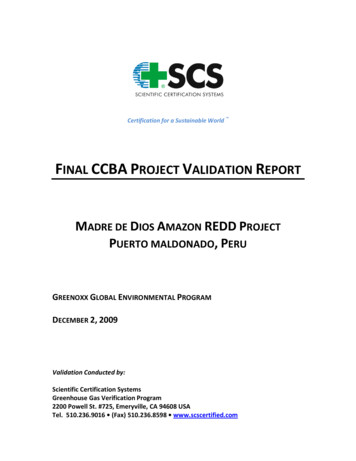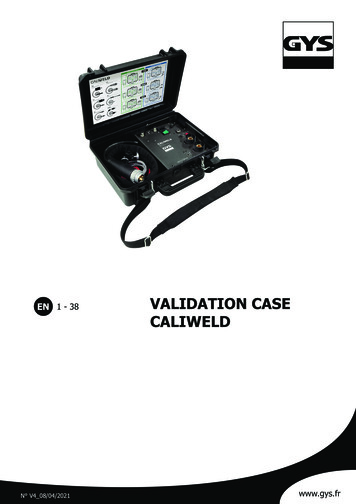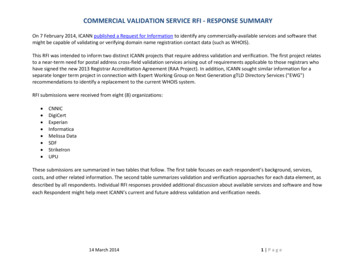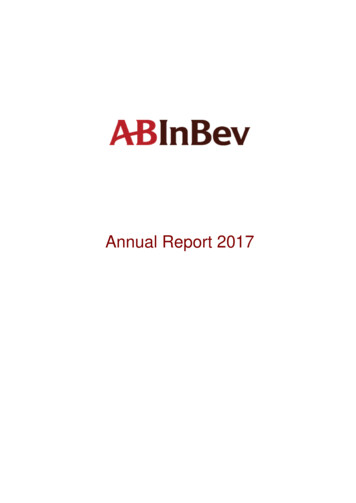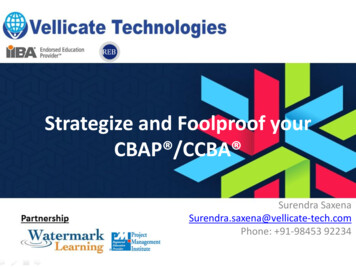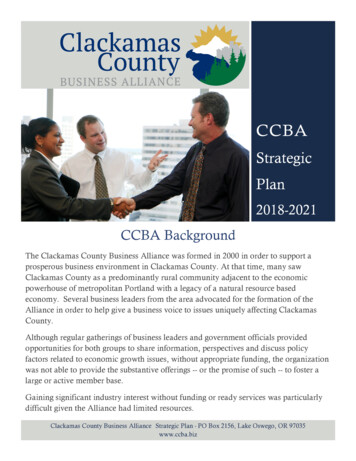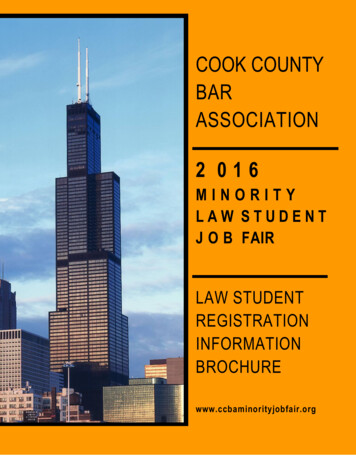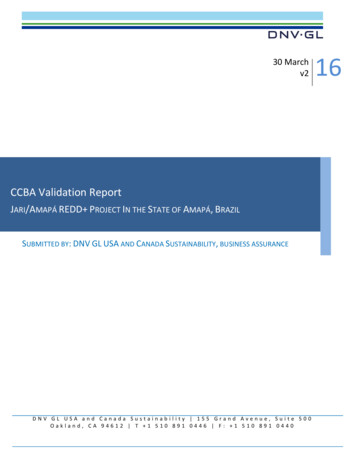
Transcription
30 Marchv2CCBA Validation ReportJARI/AMAPÁ REDD PROJECT IN THE STATE OF AMAPÁ, BRAZILSUBMITTED BY: DNV GL USA AND CANADA SUSTAINABILITY, BUSINESS ASSURANCEDNV GL USA and Canada Sustainability 155 Grand Avenue, Suite 500Oakland, CA 94612 T 1 510 891 0446 F: 1 510 891 044016
Date of first issue: 11 March 2016Project No.: PRJC-514042-2014-CCS-USAApproved by: Tom GosselinOrganizational unit:Change ServicesDNV GL USA & Canada Sustainability – ClimateClient:BiofílicaInvestimentos Client Contact: Rebeca LimaAmbientais S.A., Jari Celulose S.A. andJari Florestal S.ASummary:DNV GL (USA) has performed a validation of the “Jari/Amapá REDD Project” in the state of Amapá, Brazil on thebasis of criteria defined by the Climate Community and Biodiversity (CCB) Standards Third Edition and the VCSmethodology, “VM0015 – Methodology for Avoided Unplanned Deforestation, version 1.1, 3 December 2012” aswell as criteria for consistent project operations, monitoring and reporting. This validation report summarizes thefindings of the CCBS validation.The validation consisted of the following three phases: i) a desk review of the project design, the baseline and themonitoring plan, ii) an onsite inspection and follow-up interviews with project stakeholders and the issuance of thefinding list, and iii) the resolution of outstanding issues and the issuance of the final validation report and opinion.The project activity is to employ carbon finance in order to avoid unplanned deforestation of tropical forests andtherefore reduce greenhouse gas emissions. The project utilizes a Reduced Emissions from Deforestation andDegradation (REDD ) project methodology, specifically using forest protection and monitoring as well asimplementing sustainable development activities among the communities in order to reach emissions reductionsgoals.In summary, it is DNV GL’s opinion that the “Jari/Amapá REDD Project” in the state of Amapá, Brazil, asdescribed in the CCBA Project Design Document /75/ version 2.0, meets all relevant CCBA requirements.Report No.:Subject group:2016-7836EnvironmentIndexing terms:Report title:Key words:Validation Report for the Jari/Amapa REDD Project in the state of Amapa, Work carried out by:Kyle HollandNo distribution without permission from the client orresponsible organizational unitWork reviewed by:Edwin AaldersFree distribution within DNV after 3 yearsStrictly confidentialDate of this revision:RevisionNo: 0230 March 2016Number ofpages:86(withappendix)Unrestricted distribution Det Norske Veritas (U.S.A.), Inc.Det Norske Veritas (U.S.A.), Inc. 155 Grand Avenue, Suite 500, Oakland, CA 94612All rights reserved. This publication or parts thereof may not be reproduced or transmitted in any form or by any means, includingphotocopying or recording, without the prior written consent of Det Norske Veritas (U.S.A.), Inc.
ABBREVIATIONSAFOLUAgriculture, Forestry and Other Land UsesCARCorrective Action RequestCCBAClimate Community and Biodiversity AllianceCCBSClimate Community and Biodiversity StandardCDMClean Development MechanismCITESConvention on International Trade in EndangeredSpecies of Wild Fauna and FloraCLClarification RequestCO2Carbon DioxideDRDocument ReviewDSEASocioeconomic and Environmental AssessmentFAOFood and Agriculture Organization of the UnitedNationsFPICFree, Prior and Informed ConsentFSCForest Stewardship CouncilGHGGreenhouse Gas(es)GWPGlobal warming potentialHCVHigh Conservation Value(s)IBAMABrazilian Institute of Environment and RenewableNatural ResourcesIEFState Forestry InstituteIUCNInternational Union for Conservation of NaturePDDProject Design DocumentREDD Reduced Emissions from Deforestation andDegradation plus sustainable management offorests, conservation of forest carbon stocks andenhancement of forest carbon stocksRURAPAmapá Rural Development InstituteSEMASecretary of State for the EnvironmentSFMSustainable Forestry ManagementSRAARegional Secretariat for Agriculture andEnvironmentTARETechnical Assistance and Rural ExtensiontCO2eTonnes CO2 equivalentVCSVerified Carbon StandardVCSAVCS AssociationVCUVoluntary Carbon Unit
Table of Contents1. Introduction .2a. Objective . 2b. Scope and Criteria . 2c. CCB Project Description . 3d. Level of Assurance . 42. Methodology .4a. Review of Documents . 5b. Follow-up Interviews . 11c. Site Inspections. 13d. Resolution of Any Material Discrepancy . 133. Validation Findings . 14a. 1. General Section . 14b. 2. Climate Section. 20c. 3. Community Section . 22d. 4 Biodiversity Section . 26CCBS Compliance Checklist . 31APPENDIX A . 32
1. IntroductionBiofílica Investimentos Ambientais S.A, Jari Celulose S.A. and Jari Florestal S.A (from henceforth referredto as the “project proponents”) has commissioned DNV GL (U.S.A.) Inc. Climate Change & EnvironmentalServices (DNV GL) to perform a validation of the “Jari/Amapá REDD Project” (the project) in the state ofAmapá, Brazil. This validation report provides a description of the steps involved in conducting thevalidation and the findings of the validation based on the Climate, Community and Biodiversity Standards(Third Edition) (CCBS), as well as criteria for consistent project operations, monitoring and reporting.The validation team consisted of the following ect ManagerHirstMichelleUSATechnical reviewerAaldersEdwinNorwayTA 14.1 competenceTeam leader(Validator)Technical reviewCountrySupervision of workFirst NameReportingLast NameSite visit / InterviewsRoleDesk reviewType of involvementa. ObjectiveThe purpose of a validation is to have an independent third party assess the project design against allcriteria set out by the CCBA. Validation is a requirement for all CCBA projects and is seen as necessary toprovide assurance to stakeholders of the quality of the project and its intended climate, community, andbiodiversity benefits. The final decision on the registration of a proposed project rests with the CCBA.b. Scope and CriteriaThe validation scope is defined as an independent and objective review of the CCBA Project DesignDocument (CCBA PDD). The CCBA PDD is reviewed against the criteria stated in the CCB Standards (ThirdEdition – December, 2013), and the the VCS methodology, “VM0015 – Methodology for AvoidedUnplanned Deforestation, version 1.1, 3 December 2012.”
In particular, the project was assessed against the CCB Standards Third Edition to determine which of thefourteen required and three optional CCB Standards criteria the project satisfies. As specified by CCBA,an ‘approved’ project is one that meets all 14 of the required CCB Standards criteria.The validation is not meant to provide any consulting for the project participants. However, statedrequests for clarifications (CL) and/or corrective actions (CAR) may have provided input for improvementof the project design.c. CCB Project DescriptionThe “Jari/Amapá REDD Project” has been developed under a partnership between BiofílicaInvestimentos Ambientais S.A., Jari Florestal S.A. and Jari Celulose S.A. (the latter two both belonging toGrupo Jari) which are all based in Brazil. The project activity is to employ carbon finance in order to avoidunplanned deforestation of tropical forests and therefore reduce greenhouse gas emissions. The projectutilizes a Reduced Emissions from Deforestation and Degradation (REDD ) project methodology,specifically using forest protection and monitoring as well as implementing sustainable developmentactivities among the communities in order to reach emissions reductions goals. During the projectlifetime, the project also provides biodiversity conservation and socio-economic benefits to localcommunities living within and around the project area.Land use pressures in the area include agricultural and grazing development as well as humansettlements and large infrastructure work. Thus project treatments are aimed at three main areas:forest protection and monitoring, scientific research; especially related to natural resources andbiodiversity as well as socio-economic development of communities with a focus on sustainable businesschains. Integrating FSC (Forest Stewardship Council) certified low impact forest management andrevenue from carbon credits brought about by REDD project activities are essential in order to carry outthese project treatments so that they are effective.The project is located in the Brazilian state of Amapá, specifically within the Valley of Jari, in themunicipalities of Laranjal do Jari and Vitória do Jari. The Valley of Jari fills a significant biodiversity role inproviding habitat for a variety of diverse flora and fauna, some of which are considered threatened orendangered, and it also serves as an ecological corridor between several conservation areas. Over twothousand rural families live in and depend on the resources of the valley.The project zone consists of 240,696 hectares of several different forest types including open and densesub-montane Ombrophilous forests, lowland Ombrophilous forest and river-influenced pioneerformation forests. Other vegetative classes present within the project zone include freshwater waterswamp and floodplain vegetation as well as wooded savanna without riparian forest and savannaparkland without riparian forest. The project area is embedded within the project zone and consists of65,980 hectares of the above described dryland forest types. Within the project area, all land hasqualified as forest as defined by the 2010 FAO definition for a minimum of 10 years prior to the projectstart date of February 14, 2011 /75/.The project has been developed as a REDD project under the Verified Carbon Standard (VCS) and hasbeen validated and undergone a previous successful verification. The project is now looking to qualify asa REDD project under the Climate, Community and Biodiversity Standard so that its project activitiesrelating to biodiversity conservation and enhancement of sustainable socio-economic activities may berecognized. The project has elected for a 30 year crediting period starting on February 14, 2011 and
ending on February 14, 2041. The project start date was established as the date when the first socioeconomic and environmental assessment planning meeting was held.d. Level of AssuranceDNV GL provides reasonable assurance that the emission reduction estimations for the “Jari/AmapáREDD Project” are conservative and meet the CCBS criteria and approved VCS methodology “VM0015 –Methodology for Avoided Unplanned Deforestation, version 1.1, 3 December 2012” criteria.To ensure complete transparency, DNV GL has included any clarification or corrective actions that wereraised in this validation report in an appendix found at the end of this report (see Appendix A).2. MethodologyThe validation consisted of the following three phases: A desk review of the project design and the baseline and monitoring methodology. Site visit and interviews with project stakeholders. The resolution of outstanding issues and the issuance of the final validation report and opinion.The validation process includes the following events and activities: Opening meeting, introduction and project orientation;Desk Review of the Project Design Document (PDD) and supplemental documentation includingdata, models, and maps of project zone;Site visit from 21 September 2015 to 25 September 2015. The site visit included:o Project overview and orientationo Interviews with representatives of the communities of Vitória do Jari;o Interviews with assistants of the RURAP group;o Interviews with local community members in the vicinities of Laranjal do Jari and Vitóriado Jari;o Interview with the Regional SEMA manager;o Interview with the Secretary of the SRAA ;o Interviews with members of the local retired communityo Interviews with staff of Fundação JARIo Interviews with staff of the Forestry Department of Fundação JARI;o Interviews with staff of Jari Celuloseo Field tours of the project area;o Field tours of the local communitieso Closing meeting and presentation of preliminary findings.Review of stakeholder comments;Review of collected evidence and supporting documentation;Issuance of findings;Project proponent responses to findings;Preparation of final report;Technical review of final report;
Submission of final report to CCBA.Findings established during the validation can either be seen as a non-fulfilment of validation protocolcriteria or where a risk to the fulfilment of project objectives is identified (see Figure 1). CorrectiveAction Requests (CAR) are issued where: Mistakes have been made with a direct influence on project results. Validation protocol requirements have not been met. There is a risk that the project would not be accepted as a VCS or CCBA project or that emissionsreductions will not be certified.The term Clarification (CL) may be used where additional information is needed to fully clarify an issue.Draft report corrective actionrequests and requests forclarificationsProject participants’ responseFinal conclusionIf the conclusions from the draftValidation are either a CorrectiveAction Request or a ClarificationRequest, these should be listed inthis section.The responses given by theproject participants during thecommunications with thevalidation team should besummarized in this section.This section should summarise thevalidation team’s responses and finalconclusions. The conclusions shouldalso be included in Table 1, under “FinalConclusion.”Figure 1: Validation Protocol Tablea. Review of DocumentsThe Project Design Document version 2.0 dated February 3, 2016 /75/ was submitted by the projectproponents along with additional background documents related to the project design and baseline,which were assessed as part of the validation. The project documentation followed the guidance set outin the CCB Standards, Third Edition - December 2013.The following table lists the documentation that was assessed during the validation:Documentation provided that relate directly to the VCS and climate portions of the project:RefName of Document with Author and Description/1/Amapa RiskTool v.3.doc; Biofílica Investimentos Ambientais S.A.; Non-Permanence RiskReport/2/FAO2001.pdf; Food and Agriculture Organization of the United Nations; ProtectingPlantations from Pests and Diseases/3/Montagnini & Jordan (2005), pg.30.pdf; Florencia Montagnini and Carl Jordan; Tropical ForestEcology: The Basis for Conservation and Management, assorted excerpts/4/Montagnini & Jordan (2005), pg.31.pdf; Florencia Montagnini and Carl Jordan; Tropical ForestEcology: The Basis for Conservation and Management/5/Montagnini & Jordan (2005), pg.32.pdf; Florencia Montagnini and Carl Jordan; TropicalForest Ecology: The Basis for Conservation and Management
RefName of Document with Author and Description/6/Nair, 2001.pdf; K.S.S. Nair ; Pest Outbreaks in Tropical Forest Plantations/7/Amapa MonitoringReport 2012e2013 v.3.2.docx; Biofílica Investimentos Ambientais S.A.;Monitoring Report/8/Activities and Investments Schedule updated.xlsx; Biofílica Investimentos Ambientais S.A;Activity Investment Plan with costs and scheduling/9/Convenio Conta REDD .doc; Biofílica Investimentos Ambientais S.A; Project proponentsworks contract, evidence of roles and responsibilities/10/VCS PDD English v.2.docx; Biofílica Investimentos Ambientais S.A; Project Description/11/Proj Investment Plan 20151015.pdf; Biofílica Investimentos Ambientais S.A; ProjectInvestment Plan Presentation/12/Fundo Socio Ambiental REDD Jari - Final.pptx; Biofílica Investimentos Ambientais S.A;Social-environmental Program Presentation/13/Monitoring accuracy assessment v2.rar; Biofílica Investimentos Ambientais S.A; Shapefilesfor accuracy assessment samples/14/Aspectos e Impactos do Grupo Jari.xls; Biofílica Investimentos Ambientais S.A; Monitoring ofsocial impacts management 26 January 2016/15/PMFS Para updated.pdf; Jari Florestal; Sustainable Forest Management 2014/2015/16/CAR 6 CL 1 CL 16; Grupo Jari; Herbicide Application Instructions/17/PA - Controle de Formigas rev 11.pdf; Jari Celulose ; Ant Control instructional document/18/PA - Controle de lagartas.pdf; Grupo Jari ; Caterpillar Control instructional document/19/PA - Plano de atendimento Ö incàndios florestais rev 0.009.pdf; Jari Celulose ; Forest fireemergency plan document/20/PA - Prevená o e controle de incàndios florestais rev 0.006.pdf; Jari Celulose ; Preventingforest fires instructional document/21/Cronograma de palestras nas Comunidades - 2013.pdf; Grupo Jari ; Forest fire lectureschedule 2013/22/Cronograma de palestras sobe incêndios florestais - 2012.pdf; Grupo Orsa (Former GrupoJari); Forest fire lecture schedule 2012/23/Memórias Workshop Estratégico Jari – 07 de Outubro de 2014.pdf; Grupo Jari ; StrategicWorkshop minutes – October 7, 2014/24/Memórias consultas conta REDD .pdf; Biofílica Investimentos Ambientais S.A; StrategicWorkshop notes & questions – October 7, 2014/25/AMAPA Baseline Study 2011.pdf; Biofílica Investimentos Ambientais S.A; Amapa BaselineStudy 2011/26/VCS Monitoring Report Jari-Amapá Project 2012 2013 v3.xlsx; Biofílica InvestimentosAmbientais S.A; Monitoring report GHG calculation tables
RefName of Document with Author and Description/27/VCS Verification Report Biofilica DNV v1 Final.pdf; DNV GL; Most recently submitted VCSverification report (pending approval from VCS)Documentation provided that relate directly to the CCBA portion of the project:RefName of Document with Author and Description/28/AMAPA DSEA Relatório Final.pdf; Biofílica Investimentos Ambientais S.A; EnvironmentalDiagnosis of Jari/Amapa Region/29/AMAPA DSEA Relatório Final Anexos.pdf; Biofílica Investimentos Ambientais S.A; Annexesfor the Environmental Diagnosis of Jari/Amapa Region/30/DSEA Poema.pdf; Jari Cellulose, Poema; Socio-environmental Diagnosis of Jari/AmapaRegional Communities/31/201303 RelFJ.pdf; Biofílica Investimentos Ambientais S.A, Fundação JARI ; Quarterly reportfor Spring 2013/32/201403 RelFJ.pdf; Biofílica Investimentos Ambientais S.A, Fundação JARI ; Quarterly reportfor Spring 2014/33/201503 RelFJ.pdf; Biofílica Investimentos Ambientais S.A, Fundação JARI; Partial executivereport for Spring 2015/34/Cochrane&Laurance2008pdf.pdf; Mark A. Cochrane, William F. Laurance; Journal article“Synergisms among Fire, Land Use, and Climate Change in the Amazon”/35/Fearnside2005.pdf; Phillip M. Fearnside; Journal article“ Deforestation in the BrazilianAmazon : history, contents and consequences”/36/Hidashi neto2012.PDF; José Hidasi Neto, Marcus Vinicius Cianciaruso; Journal article“Recurring burning effects on the functional diversity of Amazonian birds”/37/McNeeleyetal2001.pdf; Jeffrey A. McNeely; Global Strategy on Invasive Alien Species/38/Pimenteletal2001.pdf; David Pimentel et al; Journal article “Economic and environmentalthreats of alien plant, animal, and microbe invasions”/39/Annex 1 - Socioeconimic and Environmental Diagnosis 1.pdf; Biofílica InvestimentosAmbientais S.A, Orsa Florestal ; Socio-economic and environmental diagnostic study from2011/40/Annex 2 - Socioeconimic and Environmental Diagnosis 2.pdf; Biofílica InvestimentosAmbientais S.A, Orsa Florestal ; Annexes for socio-economic and environmental diagnosticstudy from 2011/41/Endangered species flora.xlsx; List of endangered plant sightings and their relative locations/42/Annex 10 - Minutes 1 Amapa Forum.pdf; State Environmental Secretary, Amapagovernment; Minutes from forum for climate and environmental services/43/Annex 15 - Signed invitation from Amapa Government.pdf; State Environmental Secretary,Amapa government, Invitation from state government.
RefName of Document with Author and Description/44/Decreto nº 5975.pdf; Brazilian government; legal decree for forest rights/45/Instrucao 05 2006.pdf; Ministry of the environment; Legal instructions for SFM activity/46/SFM Plan Amapa.pdf; Orsa Florestal; SFM management plan for Amapa/47/SFM Plan Para.pdf; Orsa Florestal; SFM management plan for Para/48/Annex 4 - Meeting 1 - State of Amapa government agencies.pdf; Instituto Estadual deFlorestas (IEF) do Amapa; Summary of state meeting with IEF/49/Annex 6 - Communities - meeting 1.pdf; Biofílica Investimentos Ambientais S.A; Signedminutes for community meeting/50/Manual Workers Safety Right.pdf; Grupo Orsa; Manual for workers’ rights and safetymeasures/51/Presentation Workers Integration Treining 2014.pdf; Grupo Jari; Presentation for workertraining for forestry operations/52/Workers Safety Rights Policy Integration Traiing Content.doc; General worker policyintroduction and FAQs/53/ISST.N º.60.POTÓ.pdf; Grupo Jari; Worker safety bulletin about harmful insects/54/ISST.67 - DENGUE PODE MATAR.pdf; Grupo Jari ; Worker safety bulletin about sanitation/55/ISST.N º 63 Quedas - Todo Cuidado é pouco.pdf ; Grupo Jari ; On-the-job worker safetybulletin/56/ATA - 1ª reuniao FAMCSA imprimir.pdf; Amapa state government environmental secretary;Minutes from climate change and environmental services meeting/57/ATA DA REUNIÃO DOS PREFEITOS.pdf; Amapa state government environmental secretary;Minutes from forest concession meeting/58/C EDS 010 2013 ConviteIIIWorkshop REDD FLOTA Biofilica.pdf; Embrapa Amapa;invitation to REDD workshop/59/Empresa Biofílica-1.pdf; Amapa state government environmental secretary; letter to projectproponents about climate change and environmental forum/60/Minuta Politica Amapaense de Mudanças CLimaticas e SA.pdf; Amapa state government; billdraft for state policy on climate change and conservation policy in the environmental sector/61/Relatorio de Visita as Comunidades Cajari.docx; Grupo Jari ; Presentation of forestmanagement and communication tool with Rio Cajari region stakeholders/62/Relatório POA 01Jari Florestal.pdf ; Jari Florestal; FSC public summary of annual forestryoperating plans/63/Relatorio de Visita as Comunidades Freguesia.docx ; Grupo Jari ; Presentation on forestmanagement, public consultation of HCVs and communication tool to stakeholders ofFreguesia/64/Activities and Investments Schedule updated.xlsx ; Biofílica Investimentos Ambientais S.A;Activity Investment Plan with costs and scheduling/
RefName of Document with Author and Description/65/Modelo REDD JARI AMAPA adicionalidade e risco CCBS 20150720.xlsx; Risks andadditionality analysis per the REDD model/66/Lista de Presença Instituições Locais.pdf; Biofílica Investimentos Ambientais S.A; Signedmeeting minutes of local institutions/67/AMAPA Consulta Stakeholders Macapa noticia site IEF.pdf ; Instituto Estadual de Florestas(IEF) do Amapa; Summary of state meeting with IEF/68/AMAPA CamaraTecnicaREDD I Agosto 2012.pdf; Biofílica Investimentos Ambientais S.A;Technical REDD review presentation/69/Lista de presença Fé em Deus França Rocha.pdf; Biofílica Investimentos Ambientais S.A;Signed meeting minutes/70/Comunidades Reuniao.jpg ; Biofílica Investimentos Ambientais S.A; Project area map withcommunities/71/Comunidades Reuniao A3.pdf ; Biofílica Investimentos Ambientais S.A; Project area mapwith land use/72/Procedimento de Recebimento de Retornos e Resolução de Conflitos – REDD Jari.pdf ;Biofílica Investimentos Ambientais S.A; Feedback and Grievance Redress Procedure/73/Annex 10 - SFM consultation - July 2014.pdf ; Grupo Jari; Summary of July 2014 meetingabout SFM activities with photographs and signatures/74/Annex 11 - SFM consultation - November 2014.pdf; Grupo Jari: Summary of November 2014meeting about SFM with photographs, signatures and feedback/75/CCB PD 201602 COMPLETE v2.docx; Biofílica Investimentos Ambientais S.A; CCBA ProjectDesign DocumentMethodologies, tools and other guidance by VCSA and CCBARefName of Document/76/VCS: VCS Guidance, Standardized Methods, version 3.3, 8 October 2013/77/VCS: VCS Policy Brief: Double Counting: Clarification of Rules, version 1.0, 1 February 2012/78/VCS: VCS Program Definitions, version 3.5, 8 October 2013/79/VCS: VCS Program Guide, version 3.5, 8 October 2013/80/VCS: VCS Project Description Template, version 3.2, 8 October 2013/81/VCS: VCS Standard, version 3.5, 25 March 2015/82/VCS: VCS Validation and Verification Manual, version 3.1, 8 October 2013/83/VCS: VCS Verification Report Template, version 3.3, 8 October 2013/84/VCS: VCS AFOLU Requirements, version 3.4, 8 October 2013/85/VCS: VCS Monitoring Report Template, version 3.3, 8 October 20130
RefName of Document/86/VCS: VCS AFOLU Non-Permanence Risk Tool, version 3.2, 4 October 2012/87/VCS: Non-Permanence Risk Report Template, version 3.1, 4 October 2012/88/VCS: VCS Methodology for Avoided Unplanned Deforestation, version 1.1, 3 December 2012/89/CDM: Guidelines on Assessment of Different Types of Changes from the Project Activity asDescribed in the Registered PDD/90/CCBA: Climate Community and Biodiversity Standard Third edition, December 2013/91/CCBA: Social and Biodiversity Impacts Assessment Manual Part 1, version 2.0, September 2011/92/CCBA: Social and Biodiversity Impacts Assessment Manual Part 2, September 2011/93/VCS: VT0001 – Tool for the Demonstration and Assessment of Additionality in VCS Agriculture,Forestry and Other Land Use (AFOLU) Project Activities, version 3.0, February 01, 2012Documentation used by DNV to validate / cross-check the information provided by the projectproponentsRefSource Name and Link/94/Protecting Plantations from Pests and Diseases; http://www.fao.org/3/a-ac130e.pdf/95/Tropical Forest Insect Pests; andsat Data; http://glovis.usgs.gov//97/Google Earth; https://www.google.com/earth//98/Fires in the Rain Forest; http://rainforests.mongabay.com/0809.htm/99/The Amazon basin in 81/n7381/full/nature10717.html/100/NASA: Severe Climate Jeopardizing Amazon se 2013-025/101/Modelling the long-term impacts of selective logging on genetic diversity and demographicstructure of four tropical tree species in the Amazon f/102/DNV Climate Change Services Accreditation ; ange-services/103/VCS approved Validation Report for the Jari/Amapá REDD t details/1115/104/VCS approved Verification Report for the Jari/Amapá REDD t details/111534
b. Follow-up InterviewsIn the period from 21 September 2015 to 25 September 2015 DNV GL conducted various interviews withcommunity members, the project proponents’ staff, staff of other involved project entities and otherstakeholders.Interview TopicsInterviewed OrganizationInterview TopicsRURAPProject design, stakeholder consultation, FPIC, andmanagement capacityJari CeluloseProject design, stakeholder consultation, netimpactsFundação JARIAll elementsrequirementsSRAAStakeholder consultation, HCVSEMAProject design, additionality and legal 22/9/2015 Sr. Pedro(Nena)/106/22/9/2015 Sr. Orlando Carvalho RURAP (Igarapé/ RURAPdas Pacas)1TechnicalAssistantG1, G3, G4, G5/107/22/9/2015 Sr. Antônio dos RURAP (IgarapéSantosBahia/ das Pacas) 1RURAPTechnicalAssistantG1, G3, G4, G5/108/22/9/2015 Raimundo (Fininho)Igarapé das PacasG1, G3, G5, B2,CM1/109/22/9/2015 Sr. OsvaldoÁgua AzulG1, G3, G5,
described in the CCBA Project Design Document /75/ version 2.0, meets all relevant CCBA requirements. Report No.: Subject group: Indexing terms: 2016 -7836 Environment Report title: Validation Report for the Jari/Amapa REDD Project in the state of Amapa, Brazil Key words: Forestry Validation Service: Validation Forestry Work carried out by:
